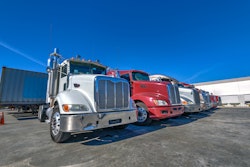Qualcomm has signed National Freight and Atlas Van Lines as customers for its untethered trailer asset management solution. Each company plans to outfit up to 4,000 trailers, starting this fall.
Molex, Inc. released FaxEnable, a system for sending two-way faxes between the office and vehicles. FaxEnable is a module that provides the interface between a standard fax machine and a digital mobile phone, such as Nextel transmission protocol, the company says.
PlanetLink Communications Inc. announced its first commercial orders of the TransTrak mobile locator device in the United States for three Atlanta-based customers. TransTrak’s features include tracking vehicle speed and location in real-time and controlling vehicle functions through remote access.
SkyBitz announced five new customers for its trailer-tracking product – Gainey Transportation, Sun Belt Transportation, Inc., MXLX Movers, Brakebush Transportation, Inc. and the Trott Group Inc. The recent additions bring its customer base to nearly 70 fleets.
StarTrak LLC said Alliance Shippers Inc. had added StarTrak’s ReeferTrak Commander to 500 of its fleet of 1,360 refrigerated intermodal trailers. The satellite-based management solution gives Alliance Shippers full two-way command and control authority over reefer assets and loads while in transit.
Wheels Inc., a provider of fleet-leasing services, introduced a push-email component called Driver Communications for its online fleet management tool called FleetView. The feature eliminates the manual process of researching, identifying and investigating compliance issues and exceptions.
Syniverse Technologies struck a Wi-Fi roaming deal with Truckstop.net, a wireless service provider that specializes in Internet connectivity at more than 500 truck stops and travel plazas. Operators using Syniverse’s Mobile Data Roaming Services will now have seamless roaming access onto Truckstop.net’s Wi-Fi network.
AerComTec’s released AerTrax V, a mobile asset location system that features digital map displays of location information delivered via password-protected websites or directly to client computers via TCP-IP. The system includes a panic/anti-carjack circuit that may be routed to a 24/7 alarm central station. Systems for trailers and other towed vehicles also are available.
Melton Technologies Inc., provider of the Horizon fleet management solution for small to medium sized fleet operators, announced that it will incorporate the KonaWare Mobility Platform to enable Horizon customers to send and receive delivery data wirelessly while en route. The end-user application will run on Pocket PC devices equipped with wide area wireless connectivity.
TMW Systems said liquid bulk carrier Service Transport Co. had selected the company’s TMWSuite as its enterprise software. Jim Brown, Service Transport’s vice president of operations, said the company is confident that the system and associated training will pay for itself in added efficiencies in less than 12 months.
Sight may be a driver’s most important sense, but there’s no guarantee that drivers will respond to hazards in plain view. All drivers are subject to inattention – diversion from events on the road due to daydreaming, fiddling with cell phones or radio settings, or reading gauges and text messages. The U.S. Department of Transportation estimates that driver distraction contributes to 90 percent of rear-end crashes. It’s no wonder, then, that radar-based obstacle detection and collision avoidance systems like Eaton’s VORAD and Transportation Safety Technologies’ Eagle Eye have grown in popularity as traffic congestion has worsened and the financial risks of crashes have increased.
One of the latest entries in rear-end collision avoidance is a visual system, Mobileye from Mobileye Vision Technologies. One feature of the Mobileye system is that it monitors not only vehicles in front but also the driver’s position in the lane. Mobileye combines a small windshield-mounted video camera, a processing unit, and audio and visual alerts.
East West Express, a 55-truck refrigerated LTL carrier based in Calgary, Alberta, is the first commercial fleet to test this virtual “third eye.” President Tom deWaal discovered the product while doing online research about driver assistance systems and liked it because it offered assistance in prevention of rear-end crashes and unintended lane departure. East West Express currently is using a pre-production model of the Mobileye system on a Kenworth W900. Superimposed on the black-and-white video display in deWaal’s test vehicle are green lines tracing the lane markings along the vehicle’s path. Surrounding vehicles are traced in white boxes, and distance from the truck is displayed. When vehicles are too close, the white boxes turn red, giving a visual cue to the problem.
If the system were to help prevent just one accident, the cost of equipping his entire fleet could be instantly recouped, deWaal says. The value of the produce and lobster the carrier hauls ranges from $180,000 to more than $1 million – and that’s not even considering the public liability exposure, he says.
“[Mobileye] mimics the decision process of what the mind goes through,” deWaal says. It also uses audible signals to capture the driver’s attention. If a driver gets too close to the lane markings with the turn signal off, a rumble strip sound comes from the left or right speaker, depending on which lane marking the truck drifts toward. Besides the visual red marking, the system also emits audible warnings when vehicles are too close in the vehicle’s headway.
The compact camera captures data in pixels. The data is sent through a cable to a small processing unit, Mobileye’s EyeQ System on a Chip, which processes it in real time (30 screens per second). The processing platform uses proprietary algorithms to determine the vehicle’s position in relation to lane markings and the speed and position of surrounding objects relative to the truck, deWaal says.
Mobileye’s optional interfaces with USB ports allow recordings on Flash memory of collision warnings. East West Express plans to use this memory feature to monitor drivers’ responses to the collision warning signals, deWaal says. By looking at a hard braking event, for example, he could tell if the incident was caused by a driver ignoring the warning or by a sudden lane cut-in from another vehicle.
The system can be used for blind-spot detection in other areas surrounding the vehicle. This function can be combined with lane change assist, which looks 60 to 70 meters backward and analyzes velocity and position of approaching vehicles to indicate whether a lane change would be safe, says Meny Benady, vice president of marketing and business development for Mobileye Vision Technologies.
After testing Mobileye for more than 37,000 kilometers, deWaal plans to install the production model in all trucks. Production versions of Mobileye will be available this December for $1,500 per unit, Benady says.
Aether sells Transportation Division
Aether Systems Inc. has signed a definitive agreement to sell its Transportation Division to an affiliate of Platinum Equity for $25 million in cash. The sale is scheduled to be completed on Sept. 30. Aether also announced plans to sell its other wireless business, the Mobile Government division, due to the company’s plans to begin focusing on investing in mortgage-backed securities.
“Aether decided some time ago that it no longer wanted to be in wireless business,” says Mike Brown, vice president of marketing for Aether Systems’ Transportation Division. The purchase agreement is a “sale of choice,” not a sale of desperation or necessity, and the change in ownership will be in the best interests of Aether employees and customers, Brown says.
“We want the industry to know that this is the same business, the same products, and the same customers going forward.”
Currently, the wireless solutions in Aether’s Transportation Division portfolio include MobileMax, a full-featured mobile communications and tracking solution; 20/20V, a GPS vehicle-tracking system; and two trailer-tracking products – TrailerMax and an exception-based asset monitoring system called GeoLogic.
Networkcar expands features
Networkcar, a Reynolds and Reynolds company, announced a new reporting suite to its Networkfleet wireless vehicle management system. Networkfleet collects and organizes information directly from a vehicle’s engine computer and location-based information from a global positioning system (GPS). Fleet owners and operators can remotely access this information in the form of immediate e-mail alerts, summary reports and easy-to-read Web pages.
With Networkfleet, dispatchers can identify and display an unlimited number of landmarks on Web-based maps, making it easy to see which driver is closest to a given customer, to predict shipment arrival times and to determine misuse of company vehicles. In addition, dispatchers quickly can locate the closest vehicle to a specific address to improve routing, the company says.
The new suite of reports include a Speed Violations Report; a Stop Details Report, which includes trip mileage, trip duration, stop location and stop duration; an Alerts Report, which is a list of vehicles that need service or have a diagnostic problem so they can repair vehicles at an earlier, less-expensive stage and decrease vehicle downtime; and an Odd-Hours Report, to identify driving-time violations to prevent unauthorized use of company vehicles after hours or on weekends.
Networkfleet now is compatible with virtually all cars manufactured since 1996 and trucks manufactured since 1988. This includes Class 1-3 passenger cars and light-duty trucks, Class 4-6 medium-duty and light-heavy duty trucks and Class 8 heavy-duty trucks.










